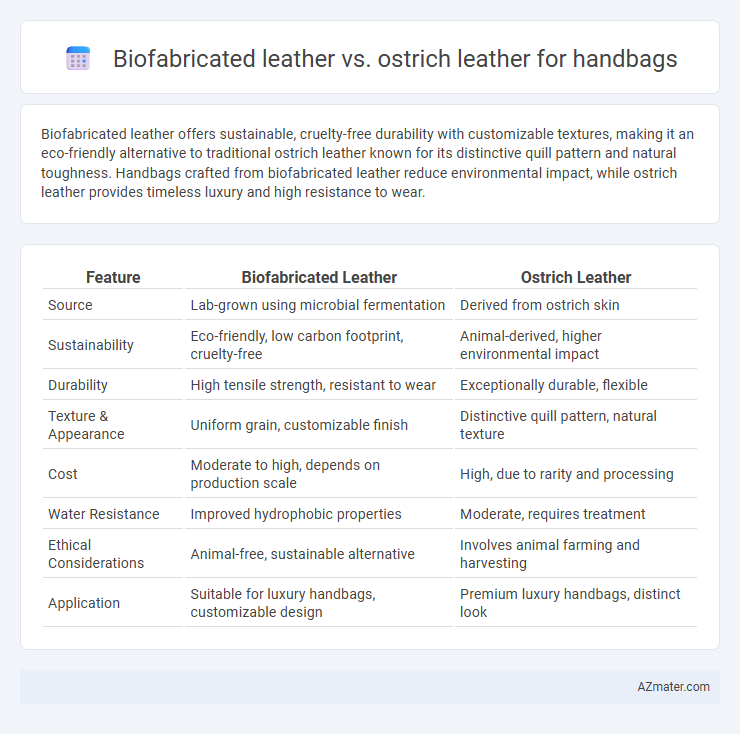Biofabricated leather offers sustainable, cruelty-free durability with customizable textures, making it an eco-friendly alternative to traditional ostrich leather known for its distinctive quill pattern and natural toughness. Handbags crafted from biofabricated leather reduce environmental impact, while ostrich leather provides timeless luxury and high resistance to wear.
Table of Comparison
| Feature | Biofabricated Leather | Ostrich Leather |
|---|---|---|
| Source | Lab-grown using microbial fermentation | Derived from ostrich skin |
| Sustainability | Eco-friendly, low carbon footprint, cruelty-free | Animal-derived, higher environmental impact |
| Durability | High tensile strength, resistant to wear | Exceptionally durable, flexible |
| Texture & Appearance | Uniform grain, customizable finish | Distinctive quill pattern, natural texture |
| Cost | Moderate to high, depends on production scale | High, due to rarity and processing |
| Water Resistance | Improved hydrophobic properties | Moderate, requires treatment |
| Ethical Considerations | Animal-free, sustainable alternative | Involves animal farming and harvesting |
| Application | Suitable for luxury handbags, customizable design | Premium luxury handbags, distinct look |
Introduction to Biofabricated and Ostrich Leather
Biofabricated leather is an innovative material created through cellular agriculture, producing sustainable, animal-free leather with comparable durability and texture to traditional hides. Ostrich leather, known for its distinctive quill pattern and natural softness, is sourced from the ostrich bird's skin, prized for high-end luxury handbags due to its unique aesthetics and strength. Comparing these materials involves considerations of environmental impact, ethical sourcing, and performance characteristics tailored to premium handbag production.
Historical Overview of Ostrich Leather in Fashion
Ostrich leather has been prized in fashion since the early 20th century for its distinctive quill pattern and exceptional durability, often associated with luxury handbags and accessories. Originating from South Africa, ostrich leather became a status symbol in the 1920s, favored by elite designers and consumers worldwide. While biofabricated leather offers sustainable alternatives, ostrich leather maintains its iconic appeal due to its rich heritage and unique texture.
What is Biofabricated Leather?
Biofabricated leather is an innovative, sustainable material created through cellular agriculture, where animal cells are cultured to produce leather without traditional animal farming. This process results in a biodegradable, cruelty-free alternative with comparable durability and texture to exotic leathers like ostrich leather. Compared to ostrich leather, which is valued for its unique quill pattern and natural toughness, biofabricated leather offers an eco-friendly solution with a significantly reduced environmental footprint for handbag manufacturing.
Environmental Impact: Biofabricated vs Ostrich Leather
Biofabricated leather significantly reduces environmental impact by minimizing water usage, greenhouse gas emissions, and land exploitation compared to ostrich leather, which requires extensive farming and resource consumption. The production of biofabricated leather relies on sustainable microbial processes that avoid animal welfare concerns and deforestation associated with ostrich farming. Consequently, biofabricated leather offers a more eco-friendly alternative for handbag manufacturing, aligning with growing consumer demand for sustainable fashion.
Durability and Performance Comparison
Biofabricated leather, created through sustainable processes using collagen proteins, offers consistent durability with resistance to wear and environmental factors, making it ideal for long-lasting handbags. Ostrich leather, renowned for its distinctive quill pattern, combines natural flexibility and strength but can be more susceptible to scratches and requires careful maintenance to preserve its performance over time. Both materials excel in durability, but biofabricated leather provides enhanced uniformity and eco-friendly advantages, while ostrich leather delivers unique texture and traditional luxury appeal.
Aesthetic Appeal and Customizability
Biofabricated leather offers unparalleled customizability in texture, color, and pattern, allowing designers to create unique and innovative handbag aesthetics that traditional ostrich leather cannot match. Ostrich leather is prized for its distinctive quill follicle pattern, providing a luxurious, natural look and feel that is highly sought after in high-end handbags. While ostrich leather's aesthetic appeal is rooted in its authentic, organic patterns, biofabricated leather enables tailored designs that align with evolving fashion trends and personalized preferences.
Ethical and Animal Welfare Considerations
Biofabricated leather offers a sustainable and cruelty-free alternative to traditional ostrich leather, eliminating the need to harm animals for fashion products. Ostrich leather involves complex animal husbandry and ethical concerns regarding the treatment and slaughter of ostriches, raising significant animal welfare issues. Using biofabricated leather significantly reduces environmental impact and aligns with growing consumer demand for animal-friendly handbags.
Cost and Market Availability Analysis
Biofabricated leather presents a cost advantage over traditional ostrich leather due to lower production expenses associated with sustainable, lab-grown materials, reducing reliance on animal farming and complex tanning processes. Ostrich leather remains a high-end option with limited market availability and premium pricing driven by its rarity, durability, and exotic appeal in luxury handbag markets. The growing demand for eco-friendly products is expanding biofabricated leather's market presence, making it an increasingly accessible alternative to expensive ostrich leather for handbag manufacturers.
Consumer Perception and Brand Adoption
Biofabricated leather is gaining traction among eco-conscious consumers who prioritize sustainable luxury, leading top fashion brands to increasingly adopt it in handbag lines to showcase innovation and environmental responsibility. Ostrich leather remains valued for its unique texture and durability, appealing to traditional luxury buyers who associate it with heritage and exclusivity. Market studies reveal a growing consumer preference shift towards biofabricated leather, driven by ethical concerns and the desire for cruelty-free alternatives, prompting brands to balance classic appeal with modern sustainability in their product offerings.
Future Trends in Sustainable Handbag Materials
Biofabricated leather offers a sustainable alternative to traditional ostrich leather by utilizing lab-grown collagen fibers that reduce environmental impact and animal exploitation. Innovations in biofabrication enable customizable textures and enhanced durability, positioning it as a leading future trend in eco-conscious handbag materials. As consumers demand transparency and ethical sourcing, the market for biofabricated leather is expected to surpass that of conventional exotic leathers like ostrich in luxury handbag production.

Infographic: Biofabricated leather vs Ostrich leather for Handbag
 azmater.com
azmater.com